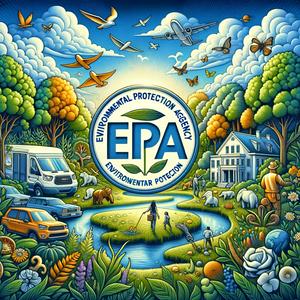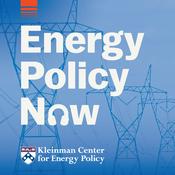141 episodes

EPA Rolls Back Landmark Rules in Trump's Second Term
12/26/2025 | 2 mins.
Welcome to your weekly EPA update, listeners. I'm your host, diving into the agency's biggest move this week: EPA Administrator Lee Zeldin just announced 31 massive deregulatory actions, calling it the greatest day of deregulation in U.S. history, according to EPA's official news release.Under Zeldin's lead in Trump's second term, the EPA is rolling back Obama and Biden-era rules left and right. Key moves include proposing to rescind the 2009 Endangerment Finding on greenhouse gases like CO2 and methane, which could wipe out vehicle emission standards entirely, as detailed in The Regulatory Review. They're also reconsidering power plant emission limits, easing oil and gas rules with extended compliance deadlines, narrowing Waters of the United States protections, and revising wastewater standards for power plants to boost energy reliability—NZero reports these target about 25% of U.S. GHG emissions from power.On the enforcement front, EPA teamed up with Customs and Border Protection at the Port of Los Angeles to crack down on toxic imports like illegal pesticides from China. "At the Trump EPA, we’re committed to securing clean air, land, and water for all Americans," says EPA Assistant Administrator Jeffrey Hall.For Americans, this means potentially lower energy bills and more reliable power, but critics from groups like the Environmental Defense Fund warn of dirtier air and higher cancer risks from things like relaxed formaldehyde rules. Businesses in energy, manufacturing, and autos stand to save billions in compliance costs, per industry analyses, while states face fewer federal mandates but possible legal battles over wetlands and streams. Globally, it signals a U.S. pivot from climate leadership, straining ties with emission-focused partners.Data point: CAFE standards jumped from 23 mpg in 2010 to 40 mpg now, pushing EVs—but rollbacks could ease that to realistic levels, SEMA notes. Public comment periods are open now through early 2026; check epa.gov for deadlines.Watch for court challenges and final rules next year. Head to epa.gov/newsreleases for details, and submit comments if you're fired up.Thanks for tuning in, listeners—subscribe for more. This has been a Quiet Please production, for more check out quietplease.ai.For more http://www.quietplease.aiGet the best deals https://amzn.to/3ODvOtaThis content was created in partnership and with the help of Artificial Intelligence AI

Biggest Deregulatory Action in US History as EPA Reshapes Environmental Policy
12/22/2025 | 2 mins.
The Environmental Protection Agency is undertaking what Administrator Lee Zeldin calls the biggest deregulatory action in U.S. history, with 31 major rollbacks announced that are reshaping American environmental policy in dramatic ways.This summer and fall, the EPA launched an aggressive assault on decades of climate and pollution regulations. In June, the agency proposed repealing greenhouse gas emissions standards for power plants, which had been the cornerstone of Obama and Biden-era climate policy. Then in August, the EPA went further, proposing to eliminate all greenhouse gas standards for vehicles, from cars to heavy-duty trucks. The agency is also reconsidering the Endangerment Finding from 2009, the legal foundation that allowed the EPA to regulate carbon dioxide as a threat to public health in the first place.What does this mean for you? If you drive a car, fuel costs might drop in the short term, but air quality could suffer. Power plants will face fewer restrictions on emissions, which utilities argue will improve grid reliability and lower energy costs. Environmental groups and public health advocates warn that allowing higher-emitting plants to operate longer will degrade air quality and increase respiratory illnesses, particularly in low-income and communities of color.The changes extend beyond climate. The EPA is reconsidering water protections, narrowing the definition of wetlands that receive federal protection. It's revising wastewater discharge rules for power plants, raising concerns about mercury, arsenic, and selenium contaminating waterways. For the oil and gas industry, the EPA announced plans to reconsider wastewater regulations to what the agency calls unleash American energy. Supporters say these moves reduce regulatory burdens and stimulate economic growth. Critics contend they weaken environmental accountability and expose communities to pollution.Several key deadlines are approaching. Public comments on a new PFAS reporting rule are due December 29th, so if you work in manufacturing or chemicals and want your voice heard, act quickly. These regulatory changes are expected to face legal challenges from states and environmental groups, and court rulings could reshape EPA authority for years to come.For citizens wanting to engage, you can submit comments on proposed rules through the Federal Register. State governments are also mobilizing, with some considering their own environmental protections.As we head into the new year, watch for court decisions that will determine whether these rollbacks stick. The EPA is fundamentally rewriting the rules, and the outcomes will affect the air you breathe and the water your community depends on for decades.Thank you for tuning in. Please subscribe for more updates on environmental policy. This has been a Quiet Please production. For more, check out quietplease dot ai.For more http://www.quietplease.aiGet the best deals https://amzn.to/3ODvOtaThis content was created in partnership and with the help of Artificial Intelligence AI

EPA Shifts to "Compliance First" Approach, Signals Deregulation Under Zeldin
12/15/2025 | 2 mins.
Welcome to your weekly EPA update, listeners. This week, the Environmental Protection Agency dropped its biggest bombshell yet: a new "compliance first" enforcement approach announced in a December 5 memorandum from Acting Assistant Administrator Craig Pritzlaff. As Holland & Knight reports, it shifts focus from drawn-out investigations and penalties to quick fixes through outreach, training, and voluntary audits—rescinding Biden-era tools like extra monitoring and pausing supplemental environmental projects.This builds on 2025's deregulatory wave under Administrator Lee Zeldin. EPA proposed repealing greenhouse gas standards for power plants and vehicles, reconsidering the 2009 Endangerment Finding that labels CO2 a pollutant, and narrowing Waters of the U.S. rules to ease burdens on farmers and builders, per NZero and EPA news releases. They're also eyeing rollbacks on particulate matter standards and hazardous air pollutants to boost manufacturing, while power plants—responsible for 25% of U.S. emissions—could see relaxed wastewater rules.For American citizens, this means potentially lower energy costs and reliable power, but critics like environmental groups warn of dirtier air and water risking public health. Businesses cheer billions in saved compliance costs and fewer lawsuits, gaining clarity via a promised single enforcement guide. States get more lead with EPA technical support, avoiding overlaps, though some may challenge rollbacks in court. Internationally, looser GHG rules could strain climate pacts, signaling U.S. priorities on energy dominance.Pritzlaff emphasized "achieving timely compliance under the clearest interpretation of the law," using LEAPS factors—Law, Evidence, Analysis, Programmatic, and Stakeholder impacts—for decisions.Key deadline: Watch for the unified enforcement guidance soon; vehicle GHG repeal comments closed in fall, with rulings possibly by mid-2026. Citizens, engage by submitting feedback on proposals at epa.gov or joining state-led compliance workshops.Next, track power sector final rules and litigation. For more, visit epa.gov/newsreleases. If input's open, speak up—your voice shapes clean air for tomorrow.Thanks for tuning in, listeners—subscribe for updates. This has been a Quiet Please production, for more check out quietplease.ai.For more http://www.quietplease.aiGet the best deals https://amzn.to/3ODvOtaThis content was created in partnership and with the help of Artificial Intelligence AI

EPA Extends Methane Reporting Deadline for Oil and Gas - Tradeoffs Between Climate, Economy, and Public Health
12/08/2025 | 3 mins.
The big EPA headline this week is a major deadline extension for oil and gas methane rules. According to S&P Global Commodity Insights, the Environmental Protection Agency has finalized a rule pushing back key methane reporting requirements for upstream oil and gas producers by 180 days, moving the main compliance deadline out to November 2026. EPA Administrator Lee Zeldin said the agency is providing “more realistic timelines” so “unrealistic regulations do not prevent America from unleashing energy dominance,” and EPA estimates companies will save about 750 million dollars in compliance costs over the next eleven years.For oil and gas operators, this buys time. Companies now have a longer runway to install monitoring equipment, sort out supply-chain issues, and build data systems for the new methane reports tied to the Clean Air Act’s performance standards for new and existing sources. Industry groups like the American Petroleum Institute praised the move, saying it supports innovation while still reducing methane, which is a powerful greenhouse gas.Environmental groups see it very differently. The Environmental Defense Fund and others argue that every extra year of unchecked methane emissions means more climate warming and more local air pollution. One EDF attorney warned that millions of Americans will be exposed to dangerous pollution for another year and a half, with higher risks for communities living near oil and gas fields.For listeners, the impact is a trade-off between short-term economic relief and long-term health and climate risks. If you live near drilling or processing sites, delays could mean more smog-forming pollution and associated respiratory problems. For businesses, especially in energy and services, the extension cuts near-term compliance pressure but adds uncertainty: legal challenges from environmental organizations and some states are already underway, and courts could still change the trajectory of these rules.State and local governments are caught in the middle. Energy-producing states may welcome the flexibility and potential job protection, while downwind or coastal states focused on climate resilience are preparing to push back in court and through their own stricter standards. Internationally, this kind of delay can complicate U.S. credibility in climate negotiations, since methane cuts are one of the fastest ways to slow near-term warming.If you want to engage, this final rule and related actions are typically open to legal and sometimes supplemental public comment. Listeners can track developments and submit feedback through the regulations section on epa.gov, contact state environmental agencies, or support local monitoring efforts that document air quality around oil and gas infrastructure.In the coming weeks, watch for court filings from states and advocacy groups, potential congressional hearings on the broader EPA deregulatory agenda, and any follow-up guidance EPA issues to clarify exactly how companies should prepare for the 2026 deadline.Thanks for tuning in, and don’t forget to subscribe so you never miss an update. This has been a quiet please production, for more check out quiet please dot ai.For more http://www.quietplease.aiGet the best deals https://amzn.to/3ODvOtaThis content was created in partnership and with the help of Artificial Intelligence AI

Podcast Episode Title: EPA's Climate Deregulation Push: Impacts on Air, Water, and Health Across America
12/05/2025 | 4 mins.
The big story from the Environmental Protection Agency this week is its push to roll back cornerstone climate protections by advancing proposals to repeal greenhouse gas standards for vehicles and power plants, and to unwind the 2009 finding that greenhouse gases endanger public health and welfare. These moves signal a fundamental reorientation of the agency from aggressive climate regulation toward a deregulatory, industry-focused agenda under the current administration.According to multiple legal and policy analysts, EPA’s proposal to rescind the Endangerment Finding and vehicle emissions standards would, if finalized, strip away the legal backbone for federal limits on climate pollution from cars, trucks, and buses. Supporters inside and outside government argue that these rules have raised costs for manufacturers and consumers, while critics, including many public health and environmental experts, warn that weakening them could mean more air pollution, higher climate risks, and greater health burdens for vulnerable communities.At the same time, the agency is proposing to relax or roll back limits on greenhouse gas emissions from fossil fuel power plants, and to narrow the scope of which waters and wetlands receive federal protection. Industry groups and some state officials say these changes could simplify permitting, support grid reliability, and reduce compliance costs, especially for energy-intensive businesses. Environmental groups and many state and local leaders counter that the long-term costs of dirtier air and water, more climate-fueled disasters, and added health care expenses will fall heavily on American families, local governments, and taxpayers.EPA is also revisiting how it evaluates certain chemicals, including formaldehyde and some PFAS substances, shifting toward approaches that many in industry praise as more flexible and “risk based,” but that health advocates fear may underestimate cancer and toxicity risks. Businesses that manufacture or use these chemicals see potential savings and fewer reporting burdens, while workers, nearby communities, and school districts worry about exposure in homes, workplaces, and classrooms. Internationally, these moves could leave the United States out of step with trading partners that are tightening climate and chemical safety rules, affecting market access and global environmental diplomacy.For listeners, the practical impact shows up in everyday life: what comes out of tailpipes and smokestacks, what’s in drinking water, and how resilient local infrastructure is to floods, fires, and heat. State and local governments may respond by setting their own stricter standards, creating a patchwork that businesses must navigate, especially in transportation, power, and construction. Experts expect a wave of lawsuits from states, NGOs, and possibly industry players seeking clarity, which means many of these changes could be tied up in court for years.There are several ways listeners can engage right now. When EPA publishes these proposals, it must take public comment, and anyone can submit views online, from small business owners worried about compliance costs to parents concerned about asthma and cancer risks in their communities. Local hearings, state rulemakings, and city climate and water planning processes are also chances to speak up, ask hard questions, and push for protections or flexibility that fit local needs.In the weeks ahead, key moments to watch include public comment deadlines on the greenhouse gas rollbacks, vehicle standards, and major chemical risk evaluations, along with any court orders that pause or overturn agency actions. For more information, listeners can visit the Environmental Protection Agency’s official website, state environmental agency pages, and reputable nonpartisan policy or health organizations that track air, water, and climate rules. Thanks for tuning in, and don’t forget to subscribe for more updates on how environmental decisions in Washington shape daily life in your community. This has been a quiet please production, for more check out quiet please dot ai.For more http://www.quietplease.aiGet the best deals https://amzn.to/3ODvOtaThis content was created in partnership and with the help of Artificial Intelligence AI
More Government podcasts
Trending Government podcasts
About Environmental Protection Agency (EPA) News
Listen to Environmental Protection Agency (EPA) News, The DSR Network and many other podcasts from around the world with the radio.net app

Get the free radio.net app
- Stations and podcasts to bookmark
- Stream via Wi-Fi or Bluetooth
- Supports Carplay & Android Auto
- Many other app features
Get the free radio.net app
- Stations and podcasts to bookmark
- Stream via Wi-Fi or Bluetooth
- Supports Carplay & Android Auto
- Many other app features


Environmental Protection Agency (EPA) News
download the app,
start listening.







































